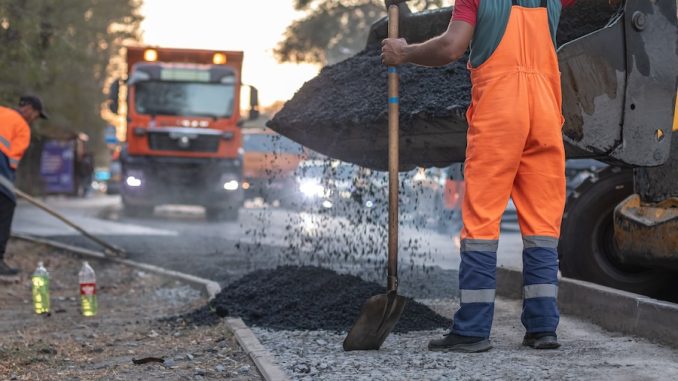
View the complete article here.
Paving in high-traffic areas—such as highways, city streets, and commercial zones—poses unique challenges for contractors. Managing traffic flow, ensuring worker safety, and minimizing disruptions while maintaining the quality of the pavement requires strategic planning and specialized techniques. This guide will cover the best practices and tips for handling asphalt paving in these busy environments.
Plan Ahead: Detailed Traffic Management and Scheduling
The key to a successful high-traffic paving project is meticulous planning. Start by developing a comprehensive traffic management plan that includes:
- Lane closures: Determine the optimal times for lane closures based on traffic patterns. Nights, weekends, or off-peak hours may be the best times to minimize disruptions.
- Detour routes: Clearly mark and communicate detour routes to minimize confusion for drivers. Coordinate with local traffic agencies and stakeholders to ensure smooth traffic flow.
- Public communication: Inform the public and local businesses well in advance of the project start date. Use digital signage, social media, and local news outlets to provide real-time updates.
Use Fast-Setting Asphalt Mixes for Quick Turnaround
When working in high-traffic areas, downtime needs to be minimized. Consider using fast-setting asphalt mixes, such as:
- Warm mix asphalt (WMA): Cools faster than traditional hot mix asphalt, allowing for quicker reopening of lanes.
- Polymer-modified asphalt: Offers enhanced durability and faster curing times, making it ideal for areas with heavy traffic loads.
Using these specialized mixes can significantly reduce the time needed before the road can be reopened to traffic.
Employ Efficient Paving Techniques
Speed and efficiency are paramount in high-traffic paving projects. Here are a few techniques that can help:
- Pave in long, continuous stretches: This minimizes the number of joints and reduces the risk of weak spots in the pavement.
- Use tandem rolling: Employ two or more rollers working together to achieve faster and more consistent compaction.
- Deploy shuttle buggies: These can help maintain a consistent flow of asphalt to the paver, reducing the chance of segregation and improving the overall quality of the pavement.
Prioritize Worker Safety
High-traffic environments increase the risk of accidents, making safety a top priority. Implement these measures to protect your crew:
- High-visibility gear: Ensure all workers wear high-visibility clothing, especially during nighttime or low-light conditions.
- Barrier protection: Use physical barriers—such as cones, barrels, and barricades—to create a buffer zone between traffic and the work area.
- Spotters and flaggers: Designate spotters and flaggers to help direct traffic and keep vehicles at a safe distance from the crew.

Invest in Real-Time Traffic Monitoring
Leverage technology to manage traffic flow effectively. Real-time traffic monitoring systems can provide live updates on congestion, allowing you to adjust your work schedule or lane closures as needed. Mobile apps and GPS-based solutions can help contractors stay informed about changing traffic conditions.
Use Temporary Pavement Markings for Driver Guidance
Clear, temporary pavement markings are essential for guiding drivers through construction zones safely. Use reflective tape, paint, or temporary markers that are easily visible—even at night or in poor weather conditions.
- Consider thermoplastic markings: These offer excellent visibility and durability, making them ideal for high-traffic areas.
- Regularly inspect markings: Check temporary markings frequently and replace any that have worn away or become less visible.
Monitor Quality Control with Intelligent Compaction
Maintaining high-quality pavement in a high-traffic area can be challenging, especially with tight deadlines. Intelligent compaction technology can help ensure a consistent, durable surface by providing real-time feedback on compaction levels.
- Track density in real-time: Use GPS-equipped rollers to monitor and adjust compaction efforts based on live data.
- Reduce the risk of over or under-compaction: Intelligent compaction helps prevent issues that can lead to premature pavement failures, such as cracking or rutting.
Prepare for Emergencies and Unexpected Delays
High-traffic projects are more susceptible to unexpected issues, such as equipment breakdowns or sudden traffic surges. Have a contingency plan in place that includes:
- Backup equipment and crews: Ensure backup equipment and personnel are on standby in case of mechanical issues or labor shortages.
- Emergency contact list: Keep an up-to-date list of contacts—including local traffic authorities, emergency services, and subcontractors—for quick communication in case of an emergency.
Final Thoughts
Handling asphalt paving in high-traffic areas requires strategic planning, efficient execution, and a strong focus on safety and quality. By employing specialized mixes, using advanced technologies, and maintaining clear communication with stakeholders and the public—contractors can successfully complete projects while minimizing disruptions.
View the complete article here.
What type of asphalt is best for high-traffic areas?
Fast-setting mixes like warm mix asphalt (WMA) or polymer-modified asphalt reduce downtime and enhance durability. How can contractors ensure safety during paving in high-traffic zones?
Use high-visibility gear, physical barriers, and spotters or flaggers to protect workers and guide traffic safely.













































